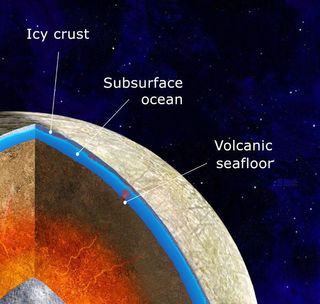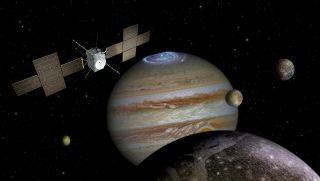This text was initially revealed at The Dialog. The publication contributed the article to House.com’s Skilled Voices: Op-Ed & Insights.
Mike Sori is an Assistant Professor of Planetary Science at Purdue College.
On Oct. 14, 2024, NASA launched a robotic spacecraft named Europa Clipper to Jupiter’s moons. Clipper will attain the ice-covered Jovian moon Europa in 2030 and spend a number of years accumulating and sending beneficial information on the moon’s potential habitability again to Earth.
Clipper isn’t the one mission highlighting researchers’ curiosity in Jupiter and its moons.
On April 13, 2023, the European House Company launched a rocket carrying a spacecraft destined for Jupiter. The Jupiter Icy Moons Explorer – or JUICE – will spend not less than three years on Jupiter’s moons after it arrives in 2031.
I’m a planetary scientist who research the construction and evolution of stable planets and moons within the photo voltaic system.
There are a lot of causes my colleagues and I are trying ahead to getting the information that Europa Clipper and JUICE will hopefully be sending again to Earth within the 2030s. However maybe probably the most thrilling info must do with water. Three of Jupiter’s moons – Europa, Ganymede and Callisto – are house to giant, underground oceans of liquid water that might help life.
Associated: SpaceX Falcon Heavy rocket launches NASA’s Europa Clipper probe to discover icy Jupiter ocean moon (video)
Meet Io, Europa, Ganymede and Callisto
Jupiter has dozens of moons. 4 of them particularly are of curiosity to planetary scientists.
Io, Europa, Ganymede and Callisto are, like Earth’s Moon, comparatively giant, spherical complicated worlds. Two earlier NASA missions have despatched spacecraft to orbit the Jupiter system and picked up information on these moons. The Galileo mission orbited Jupiter from 1995 to 2003 and led to geological discoveries on all 4 giant moons. The Juno mission continues to be orbiting Jupiter immediately and has supplied scientists with an unprecedented view into Jupiter’s composition, construction and area atmosphere.
These missions and different observations revealed that Io, the closest of the 4 to its host planet, is abuzz with geological exercise, together with lava lakes, volcanic eruptions and tectonically shaped mountains. However it isn’t house to giant quantities of water.
Europa, Ganymede and Callisto, in distinction, have icy landscapes. Europa’s floor is a frozen wonderland with a younger however complicated historical past, probably together with icy analogs of plate tectonics and volcanoes. Ganymede, the most important moon in your complete photo voltaic system, is greater than Mercury and has its personal magnetic area generated internally from a liquid metallic core. Callisto seems considerably inert in comparison with the others, however serves as a beneficial time capsule of an historical previous that’s not accessible on the youthful surfaces of Europa and Io.
Most fun of all: Europa, Ganymede and Callisto all virtually definitely possess underground oceans of liquid water.

Ocean worlds
Europa, Ganymede and Callisto have chilly surfaces which are a whole lot of levels beneath zero. At these temperatures, ice behaves like stable rock.
However similar to Earth, the deeper underground you go on these moons, the warmer it will get. Go down far sufficient and you finally attain the temperature the place ice melts into water. Precisely how far down this transition happens on every of the moons is a topic of debate that scientists hope to resolve with JUICE and Europa Clipper. Whereas the precise depths are nonetheless unsure, scientists are assured that these oceans exist.
The very best proof of those oceans comes from Jupiter’s magnetic area. Saltwater is electrically conductive. In order these moons journey by means of Jupiter’s magnetic area, they generate a secondary, smaller magnetic area that alerts to researchers the presence of an underground ocean. Utilizing this system, planetary scientists have been capable of present that the three moons include underground oceans. And these oceans will not be small – Europa’s ocean alone might need greater than double the water of all of Earth’s oceans mixed.
An apparent and tantalizing subsequent query is whether or not these oceans can help extraterrestrial life. Liquid water is a vital piece of what makes for a liveable world, however removed from the one requirement for all times. Life additionally wants vitality and sure chemical compounds along with water to flourish. As a result of these oceans are hidden beneath miles of stable ice, daylight and photosynthesis are out. But it surely’s attainable different sources may present the wanted components.
On Europa, for instance, the liquid water ocean overlays a rocky inside. That rocky seafloor may present vitality and chemical compounds by means of underwater volcanoes that might make Europa’s ocean liveable. However additionally it is attainable that Europa’s ocean is a sterile, inhospitable place – scientists want extra information to reply these questions.

Upcoming missions from ESA and NASA
Europa Clipper and JUICE are set as much as give scientists game-changing details about the potential habitability of Jupiter’s moons. Whereas each missions will collect information on a number of moons, JUICE will spend time orbiting and specializing in Ganymede, and Europa Clipper will make dozens of shut flybys of Europa.
Each of the spacecraft will carry a set of scientific devices constructed particularly to research the oceans. Onboard radar will enable Europa Clipper and JUICE to probe into the moons’ outer layers of stable ice. Radar may reveal any small pockets of liquid water within the ice, or, within the case of Europa, which has a thinner outer ice layer than Ganymede and Callisto, hopefully detect the bigger ocean.
Magnetometers can even be on each missions. These instruments will give scientists the chance to check the secondary magnetic fields produced by the interplay of conductive oceans with Jupiter’s area in nice element and can hopefully give researchers clues to salinity and volumes of the oceans.
Scientists can even observe small variations within the moons’ gravitational pulls by monitoring delicate actions in each spacecrafts’ orbits, which may assist decide if Europa’s seafloor has volcanoes that present the wanted vitality and chemistry for the ocean to help life.
Lastly, each craft will carry a number of cameras and light-weight sensors that can present unprecedented photos of the geology and composition of the moons’ icy surfaces.
Perhaps in the future, a spacecraft will have the ability to drill by means of the miles of stable ice on Europa, Ganymede or Callisto and discover oceans immediately. Till then, observations from spacecraft like Europa Clipper and JUICE are scientists’ finest guess for studying about these ocean worlds.
When Galileo found these moons in 1609, they have been the primary objects identified to immediately orbit one other planet. Their discovery was the ultimate nail within the coffin of the idea that Earth – and humanity – resides on the middle of the universe. Perhaps these worlds have one other humbling shock in retailer.





